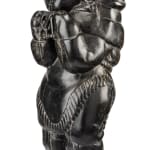-
Artworks
JOHNNY INUKPUK, R.C.A. (1911-2007) INUKJUAK (PORT HARRISON)
Mother and Restless Child, Playing Ajaraaq (String Game), late 1960sstone, 26.5 x 9.5 x 10 in (67.3 x 24.1 x 25.4 cm)
unsigned.
LOT 136
ESTIMATE: $18,000 — $28,000
PRICE REALIZED: $14,560.00Further images
Mother and Restless Child, Playing Ajaraaq (String Game) was created in the latter half of the 1960s, near the end of a decade of astonishing productivity and experimentation for the...Mother and Restless Child, Playing Ajaraaq (String Game) was created in the latter half of the 1960s, near the end of a decade of astonishing productivity and experimentation for the artist. Inukpuk’s famous early 1950s carvings were notable for their compact, rotund style (see Hessel, Inuit Art, 1998, fig. 49; First Arts, July 2020, Lot 65). By the late 1950s he was carving sizeable sculptures that were impressive for their monumental quality and showcased the artist’s strength in depicting closely observed details and gestures, evident in the present work.
Mother and Restless Child is a fine example of Inukpuk’s technical skill as a sculptor. Its broadly carved and polished surfaces allow light to play upon the features of the figures, which are almost certainly modeled after Inukpuk’s beloved wife and one of their children. Equally impressive is the intricate intercarving that is evident in the depiction of the ajaraaq string game. We are charmed by the way the young woman carefully concentrates on the string in her typically oversized hands as she engages in the game, which requires dexterity in manipulating a long loop of sinew into various figures. The woman’s hair, which falls over her shoulders in two delicate plaits, is beautifully echoed in the details of her belt and the fringe of her amautiq.
Quite apart from the overall visual appeal of the work, however, Mother and Restless Child is truly remarkable for its stroke of conceptual genius. Seen from the front, or from only one side or the other, the sculpture seems like a “normal” mother-and-child composition. But as we move around to the back, we realize that there are two children’s faces, not one. Twins then, we think. But, in fact, there is only one Janus-faced youngster! Inukpuk has depicted a curious or bored child, excitedly looking to the left and right. It’s brilliant, and in wonderfully comical contrast to the mother's patient concentration.
References: For a roughly contemporaneous, similarly themed work by the artist see Christine Lalonde, Sanaugavut: Inuit Art from the Canadian Arctic, (Ottawa: National Gallery of Canada, 2010), cat. 8, For a similarly large example of the same theme by the artist, dating a few years earlier, see Walker’s Auctions, May 2015, Lot 34; for other important works by the artist see First Arts Auction, July 2020, Lot 24; Dec. 2020, Lot 68, and George Swinton, Sculpture of the Inuit, (Toronto: McClelland & Stewart, 1972/92), fig. 55. There are other examples where an exuberant figure is depicted with multiple heads to portray frenzied movement. Manasie Akpaliapik’s magnificent Drum Dancer of 1989 (First Arts, July 2021, Lot 7) and Isaci Etidlois’ Singing Shaman (reproduced on the cover of Inuit Art Quarterly, Vol. 20. No. 2, Summer 2005) come to mind but each was produced decades after this sculpture. For information on ajaraaq (ataujartut), see Lorraine E. Brandson, Carved from the Land: The Eskimo Museum Collection, (Churchill, MB: The Eskimo Museum / Diocese of Churchill Hudson Bay, 1994), p. 154-155.
Provenance
Private Collection, Montreal;
Walker's Auction, Ottawa;
A Toronto Collection.
Join our mailing list
* denotes required fields
We will process the personal data you have supplied in accordance with our privacy policy (available on request). You can unsubscribe or change your preferences at any time by clicking the link in our emails.










